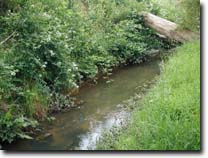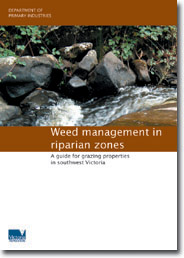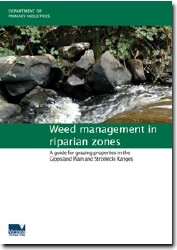Module 4: Expert weed system: A support tool for on-farm management
Productive Grazing, Healthy Rivers - Home
| Background Weed invasion was identified as a major reason why landholders resist fencing off riparian areas or undertake restoration schemes. Weed proliferation in fenced riparian areas is perceived as a threat by landholders for a variety of reasons. Landholders are usually extremely knowledgeable about local pasture weeds and the appropriate management practices for them, however, knowledge about other weeds, particularly those that affect biodiversity in ungrazed situations, is much more variable. Aim A Weed Decision Support Tool has been developed to assist farmers and landholders to determine the most appropriate management strategies for a range of weeds that occur in riparian zones. The ability to assess weed threats rapidly and identify suitable management options for riparian land should increase the willingness of landholders to undertake or continue the protection of on-farm riparian biodiversity in the project areas. |  |
Our approach
Existing information on weed distribution, their effects and their response to control measures was collated with local knowledge from farmers and others involved in riparian management in the project area. To ensure that the information is locally relevant, two different versions have been developed for the south west and eastern regions of the project area. The south west version was published in July 2004 and the version for the eastern end of the project area will be completed shortly.
The Weed Support Tool contains:
|
To view the information PDF requires the use of a PDF reader. This can be installed for free from the Adobe website (external link).
Related Links
The Cooperative Research Centre (CRC) for Australian Weed Management (external link) is working to enhance the sustainability of farming systems and the conservation status of natural ecosystems across Australia through world-class collaborative research that targets generic control problems using integrated weed management.
Contact
Dr Sharon Aarons
Ph: (03) 5624 2222
Email: Sharon.Aarons@dpi.vic.gov.au
Module 1: What lives along your stream? Quantifying on-farm riparian biodiversity
Productive Grazing, Healthy Rivers - Improving riparian and in-stream biodiversity - Project Report 2006 - Module 1 - Quantifying on-farm riparian biodiversity (PDF 289KB). To view the information PDF requires the use of a PDF reader. This can be installed for free from the Adobe website (external link).
Module 2: Wood to Water: habitat creation within restored and replanted riparian land
Productive Grazing, Healthy Rivers - Improving riparian and in-stream biodiversity - Project Report 2006 - Module 2 Wood to Water: Habitat creation within replanted riparian land (PDF 142KB). To view the information PDF requires the use of a PDF reader. This can be installed for free from the Adobe website (external link).
Module 3: Regeneration in remnant vegetation: overcoming the barriers
Productive Grazing, Healthy Rivers - Improving riparian and in-stream biodiversity - Project Report 2006 - Module 3 - Regeneration in remnant vegetation: Overcoming the barriers (PDF145KB). To view the information PDF requires the use of a PDF reader. This can be installed for free from the Adobe website (external link).
Module 4: Expert weed system: a support tool for on-farm management
Productive Grazing, Healthy Rivers - Improving riparian and in-stream biodiversity - Project Report 2006 - Module 4 - Riparian weed management system: Development of on-farm management tool (PDF 70KB). To view the information PDF requires the use of a PDF reader. This can be installed for free from the Adobe website (external link).
Module 5: Riparian condition and land-use practices: a survey of riparian health on dairy farms
Productive Grazing, Healthy Rivers - Improving riparian and in-stream biodiversity - Project Report 2006 - Module 5 - Riparian condition and land-use practices: A survey of riparian health & condition on dairy farms (PDF 127KB). To view the information PDF requires the use of a PDF reader. This can be installed for free from the Adobe website (external link).
Module 6: Riparian zone management: reducing water quality impacts from dairy cows
Productive Grazing, Healthy Rivers - Improving riparian and in-stream biodiversity - Project Report 2006 - Module 6 - Riparian zone management: Reducing water quality impacts on dairy cows (PDF 304KB). To view the information PDF requires the use of a PDF reader. This can be installed for free from the Adobe website (external link).




